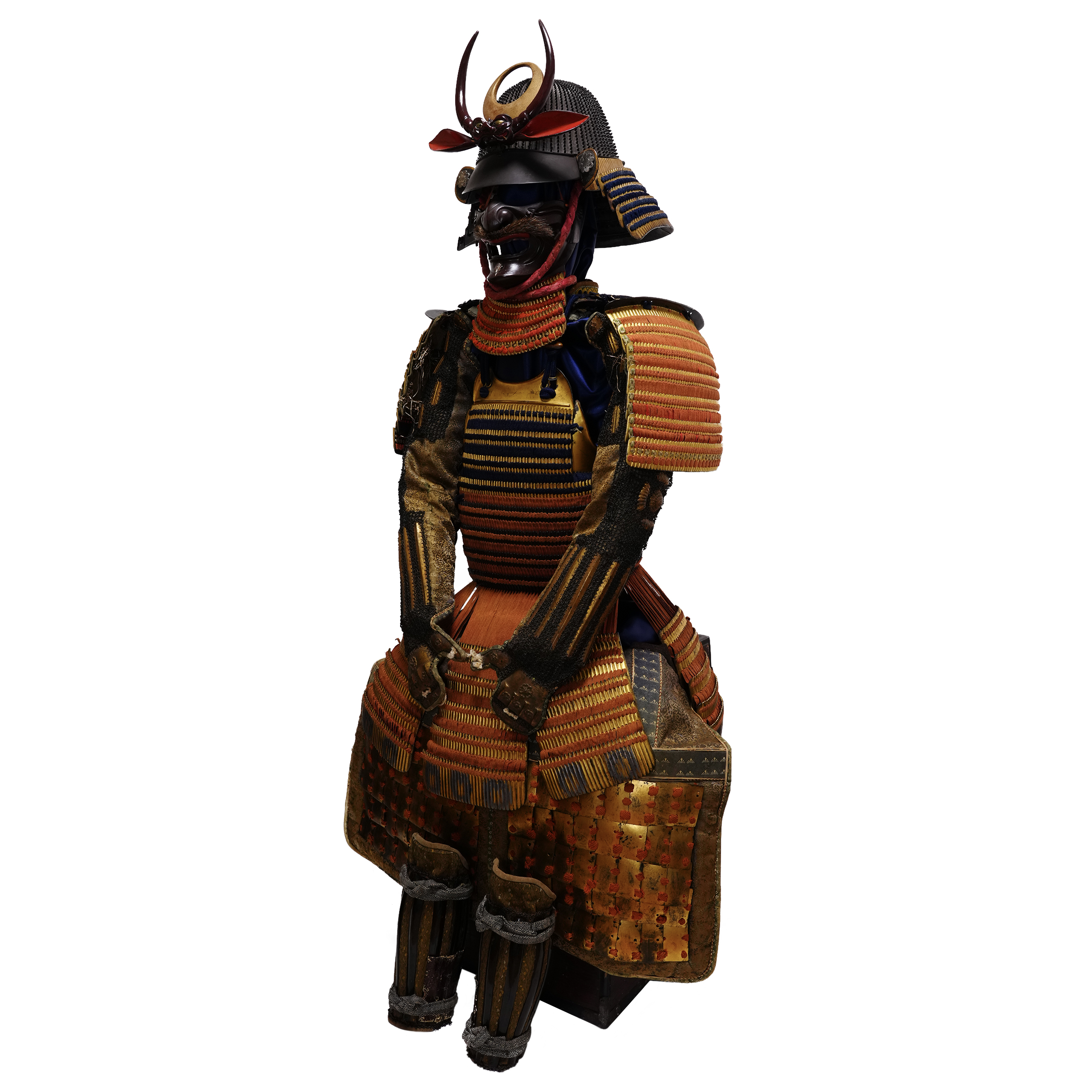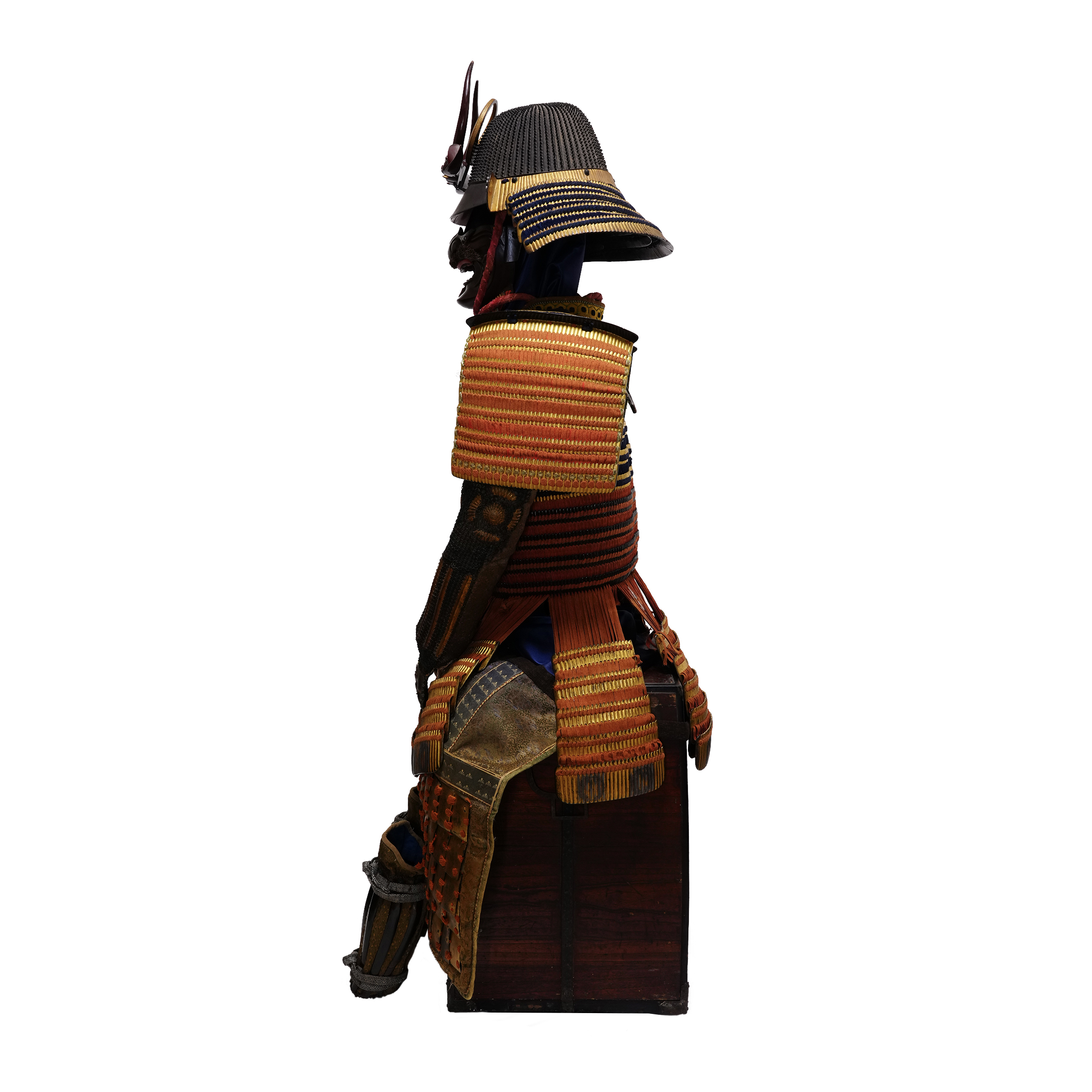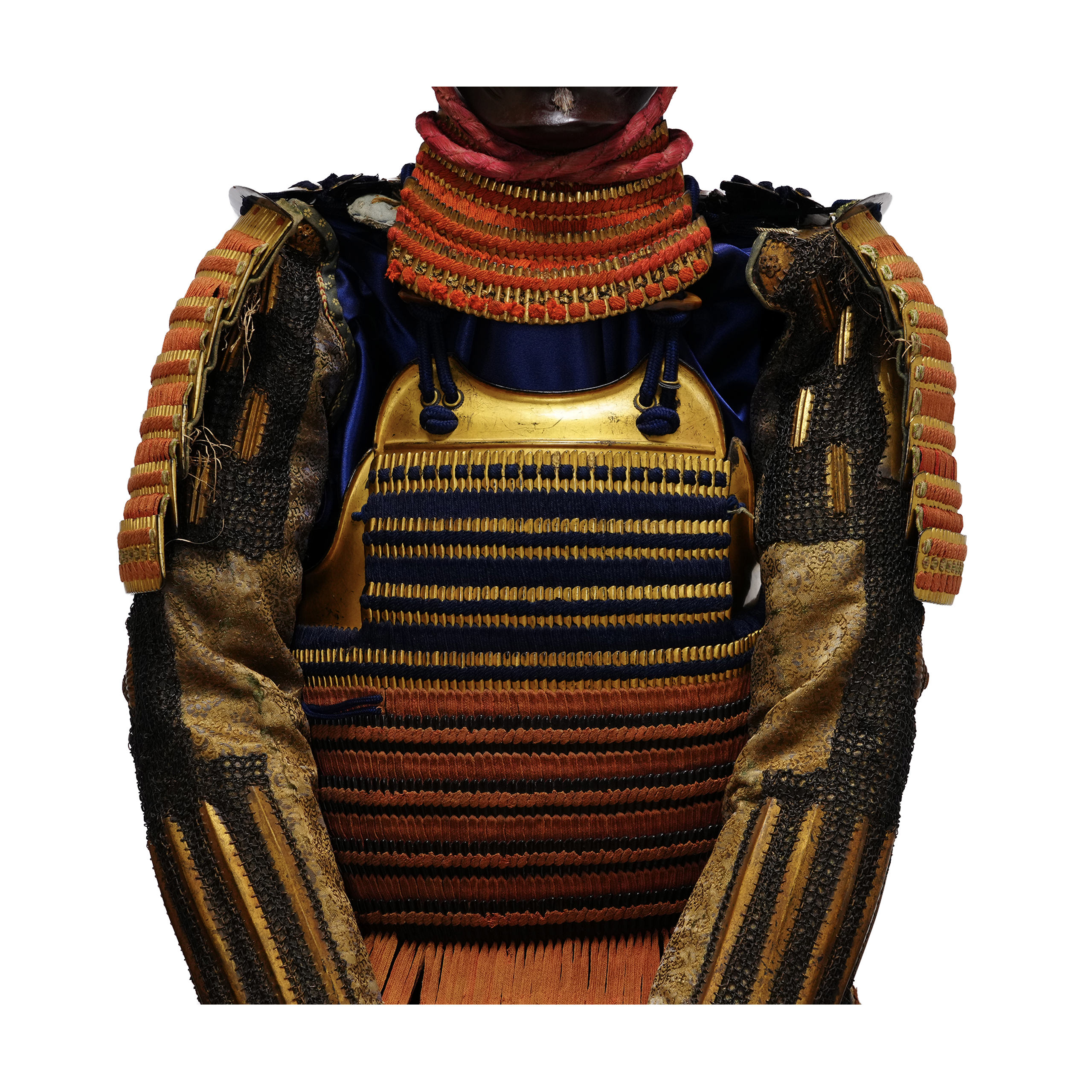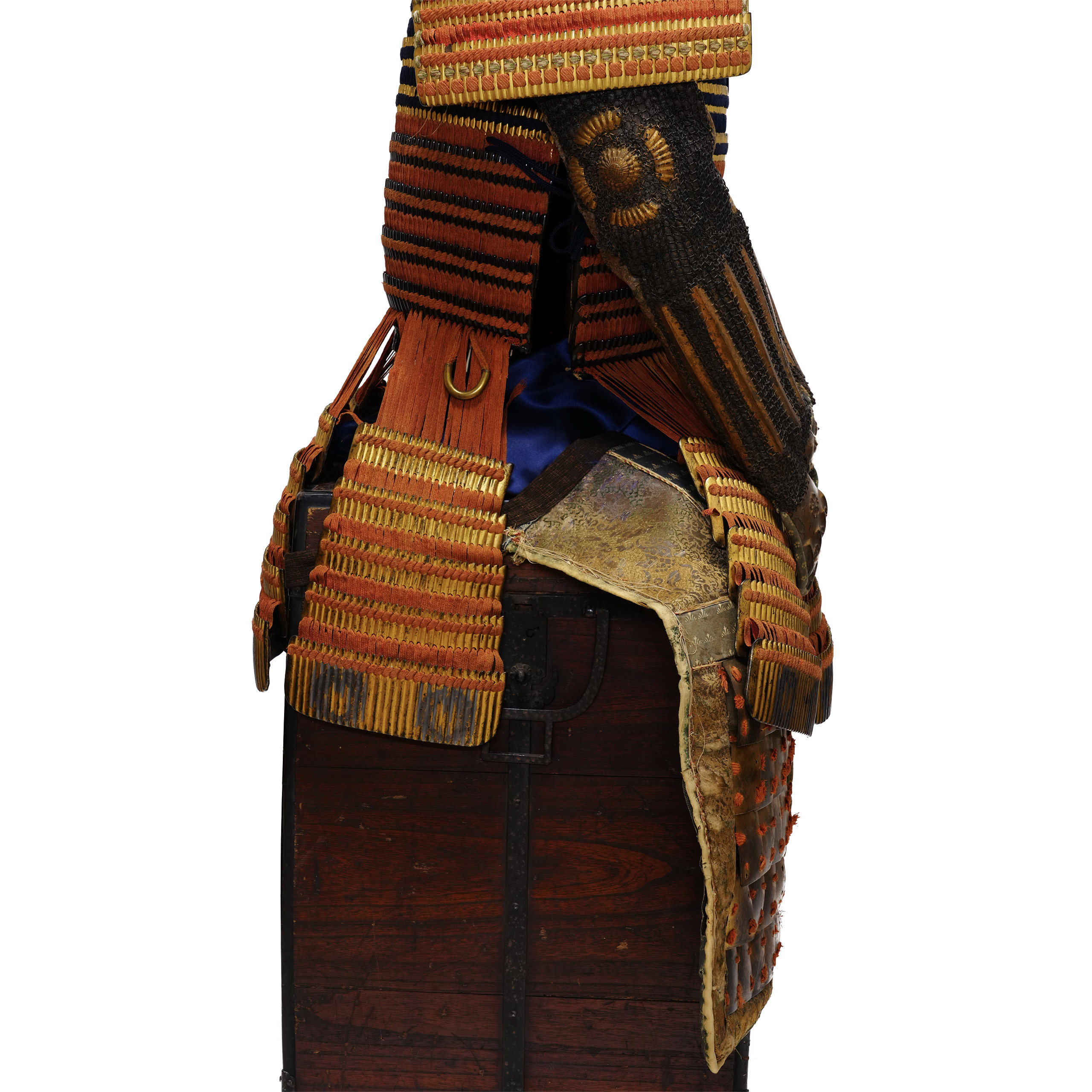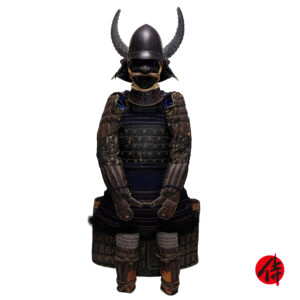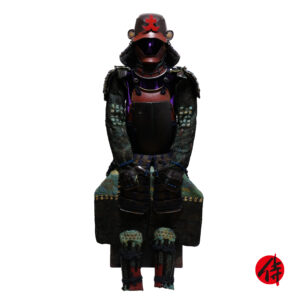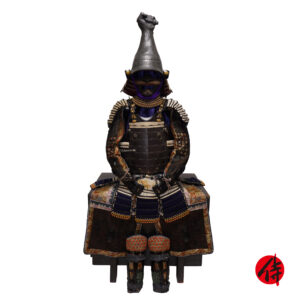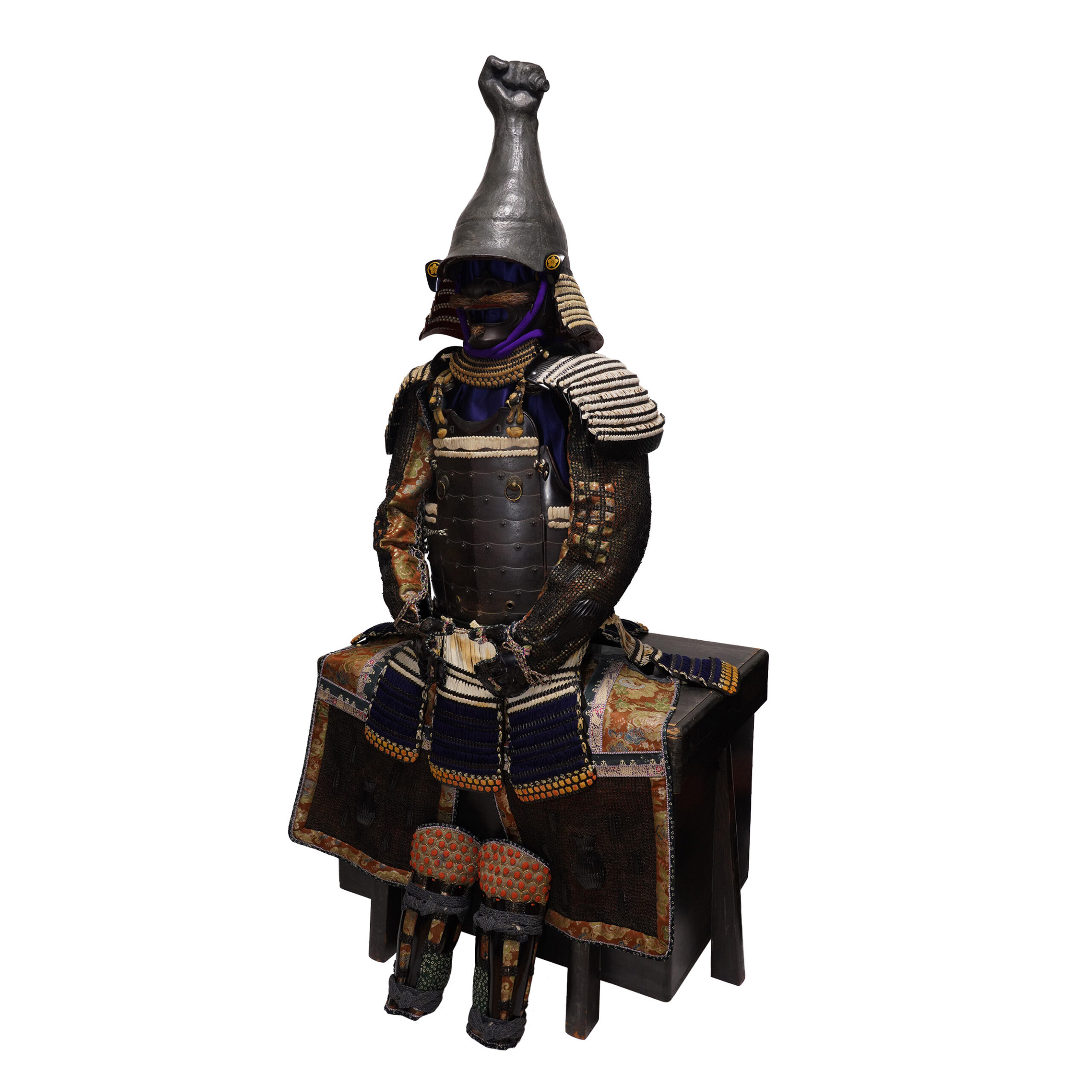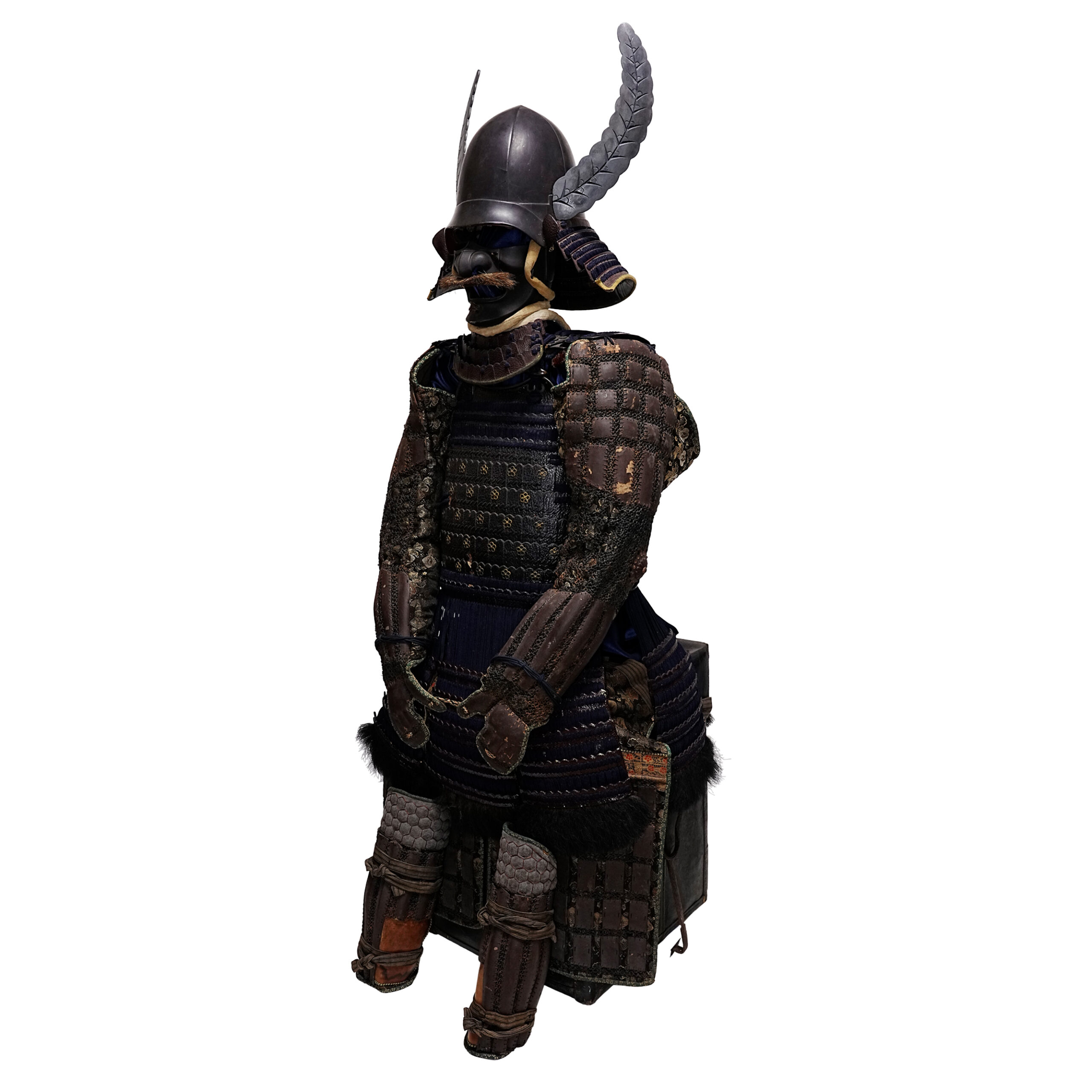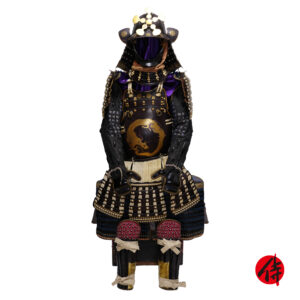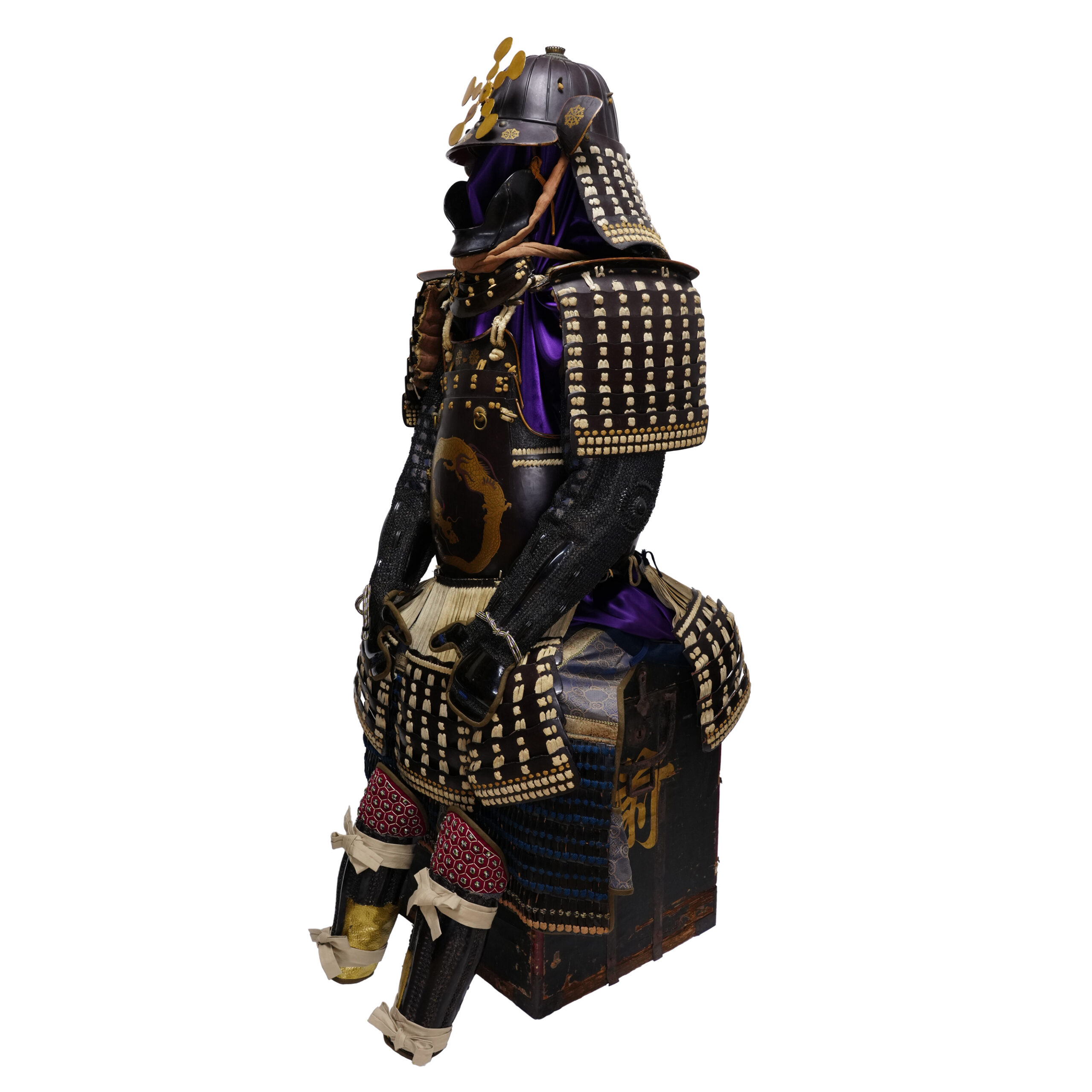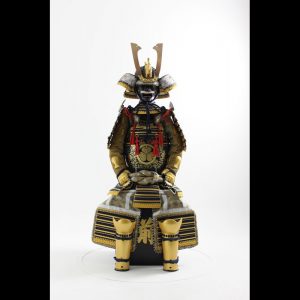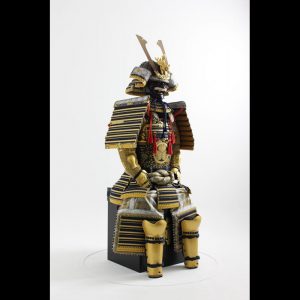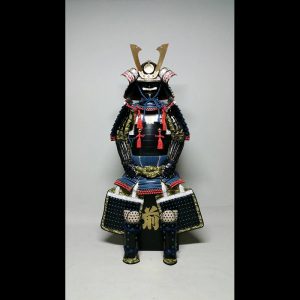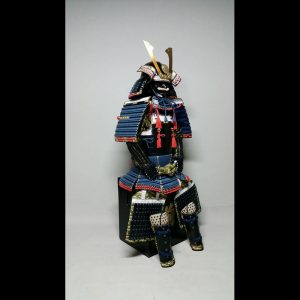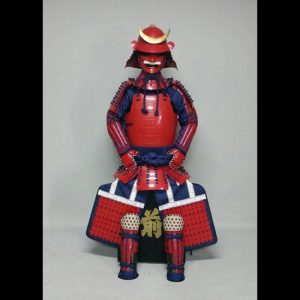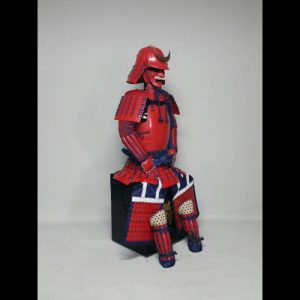Antique Early Edo Period Samurai Armor Koushu Tokubetsu Kicho Shiryo Certificate (A-35)
Period: the early Edo Period
appraised by The Association for the Research and Preservation of Japanese Helmets and Armor
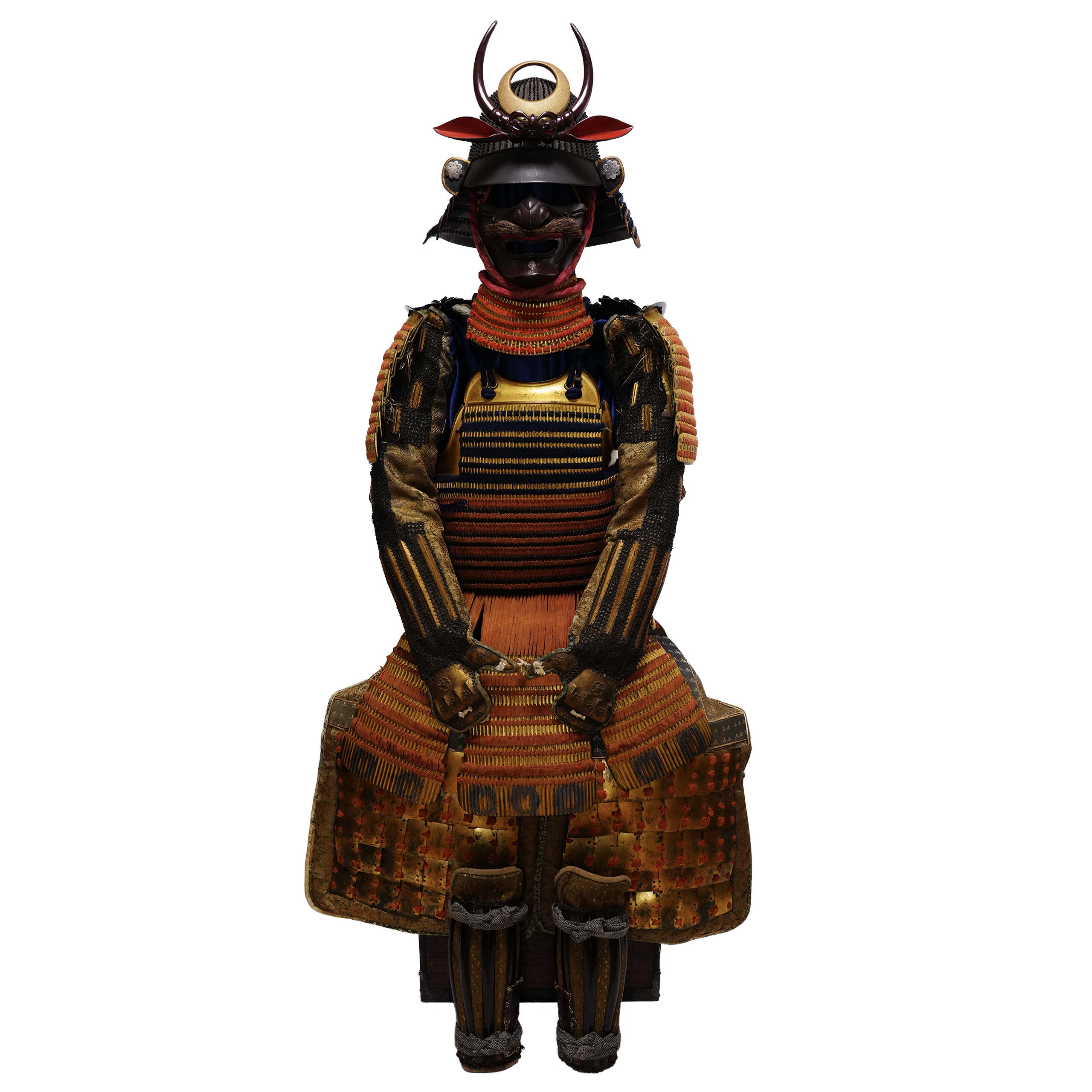
Kabuto (helmet)
■Helmet bowl: Koboshi Kabuto
We believe this Kabuto’s style is the Koboshi Kabuto (小星兜), which is categorized as the Hoshi Kabuto (星兜). The Hoshi Kabuto is a type of Samurai helmet that was born in the middle of the Heian period (平安, around 888-1068). Small rivets that hold iron plates together. These rivets are called the Hoshi (星, star). In the Edo period, artisans made Kabutos not only Kawari Kabutos (please check the paragraph below) but also ancient-style Kabutos. For example, in the case of the Hoshi Kabuto, the Hoshis become smaller toward the top of the head; this form is called the Rinotori (厘劣り). It differs from the old-fashioned Hoshi Kabuto, in which all the Hoshis were the same size.
The Kabuto (兜, helmet) is a protector for the head. When people started using the Kabuto, it was initially designed for practical use. However, the principal purpose of its design has changed with time; Samurai warriors tried to express their dignity, personality, or religion by wearing the characteristic designed Kabutos. According to a theory, these uniquely designed Kabutos were made from the late Muromachi (室町, 1336-1573) to the Edo period (江戸, 1603-1868). This type of Kabuto is categorized as the Kawari Kabuto (変わり兜), and a variety of materials were used to create them. For example, animal fur, seashells, plants, and paper were used as materials for decoration.
Here, we would like to introduce you to a little bit more about the history of Kabutos. Before the Kawari Kabuto’s production, Suji Kabutos (筋兜) appeared during the Nanbokuchou (南北朝, 1337-1392) period. At that time, the tactic was gradually changed from the piggyback fight style to battle with the Tachi (太刀) swords and the Naginata (薙刀, Japanese halberd) on the ground. Therefore, there was a rise in demand for the weight-saving of the Kabuto. Also, to turn the attack by swords, a new type of structure was invented: the Suji Kabuto. Its form slides sword attacks when weapons hit the Kabuto. It is said that the production of the Suji Kabuto prospered in the Muromachi period.

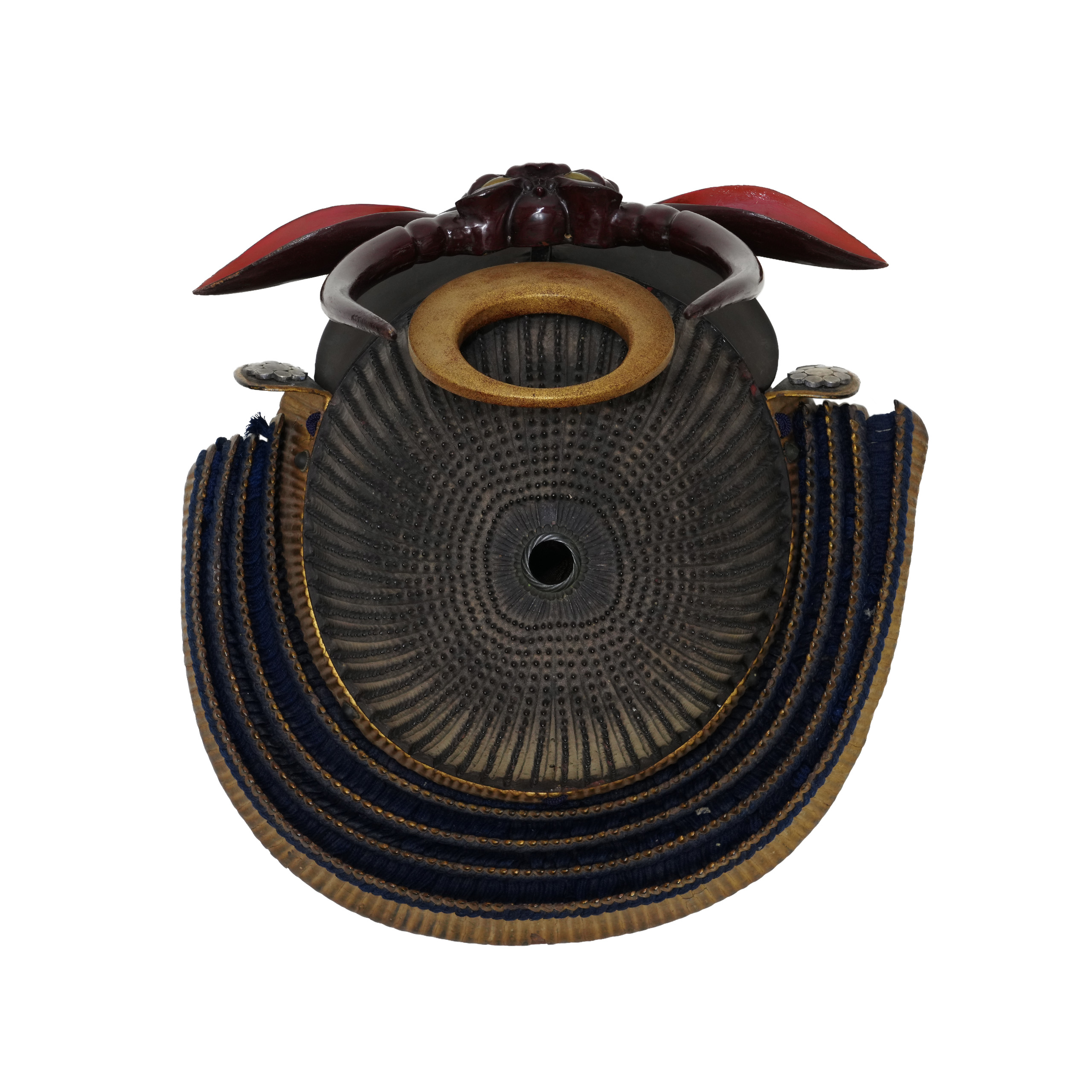
■Shikoro (side neck guard):
This Kabuto has golden Shikoro (錣, a device attached to protect the area from the back of the head to the neck), and navy blue Odoshi (縅, string that ties the boards together) is used to connect each plate part. Although some cracks and peeling are due to aging, these traces show this Kabuto’s antique texture.
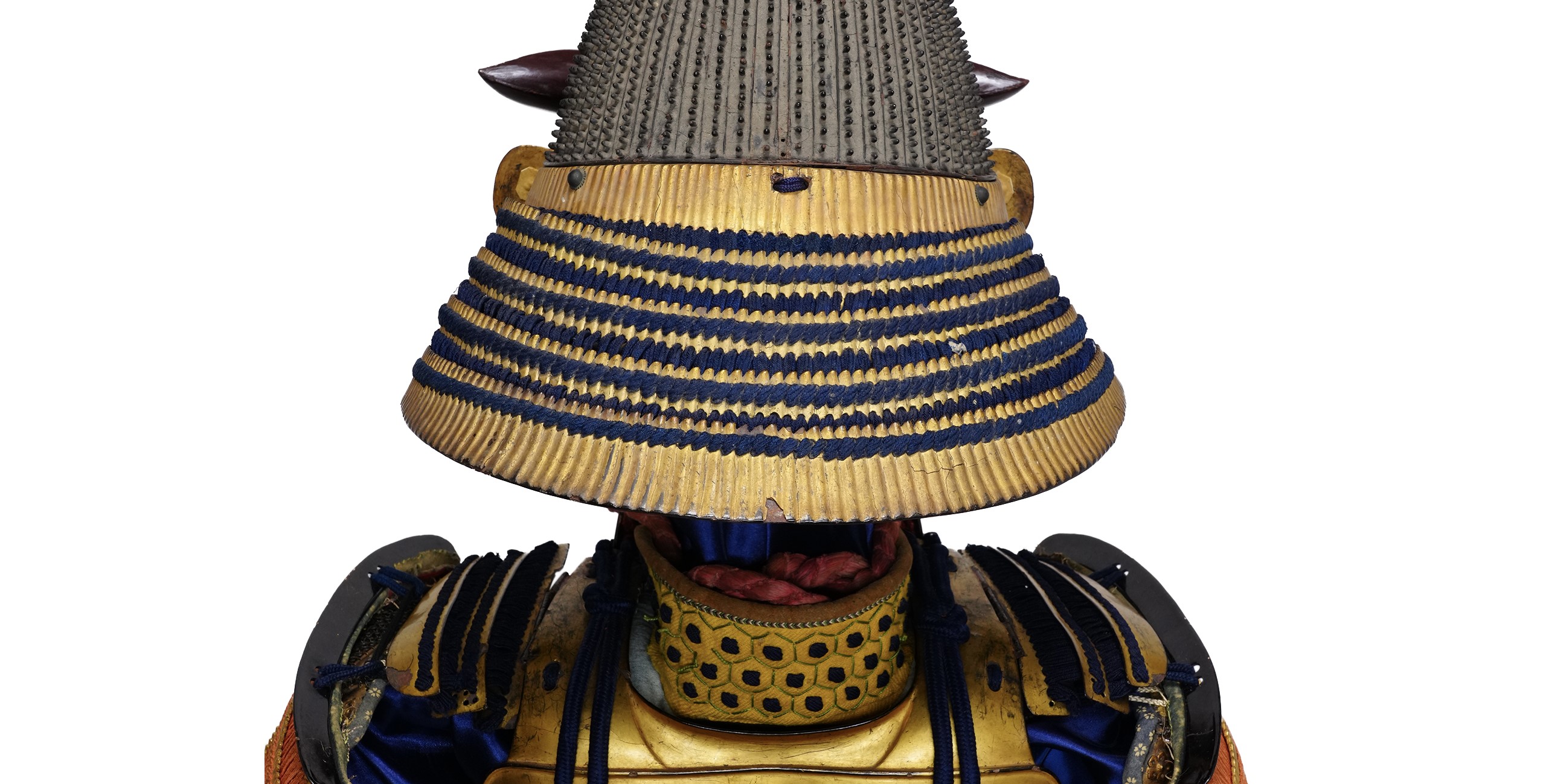
■Fukikaeshi (side neck guard): Ichimoji Mon
The Fukikaeshi (吹き返し) is both ends of a Kabuto. It protects the face from swords and also shows its beautiful workmanship. Family crests are sometimes designed on this part, as seen on this Kabuto.
You would find the combination of nine circles mark decoration is attached to the Fukikaeshi part. It is a kind of family crest called the Hoshi (星, star) pattern or the Kuyou (九曜) pattern. As its name implies, each circle represents a star. Stars have been worshipped as a holy existence that controls fate. Since each star moves in a fixed orbit, people could know the suitable position during hunting, voyages, or the agricultural season by seeing stars. That is, stars have a deep relationship with people’s daily life. With time, stars came to be treated as a design, and some people arranged it for their family crests. The Kuyou pattern is one of them.
There are various types of Hoshi Mon, such as three stars, seven stars, and nine stars. Three stars design is called the Mitsu-Boshi (三つ星) in Japanese, and it means the Kachi-Boshi (勝ち星, winning star). For warriors who lived on the battlefields, it is understandable that many Samurai warriors favored such an auspicious motif. For example, Date Masamune (伊達 政宗, 1567-1636), one of the famous warlords, used Kuyou Mon for one of his family crests.

■Menpo (face guard): Ressei Menpo
This type of Menpo is called the Ressei Menpo (烈勢面頬). It represents the angry face to intimidate enemies. There are many types of Menpo, depending on their shape or appearance. The purpose of Menpo was not only to protect Samurai’s face. But also to hide their true faces so that their psychological states were unaffected. Beards are attached to this Menpo. Thanks to this effect, even a young soldier would have been able to produce the majestic appearance of a middle-aged Samurai.
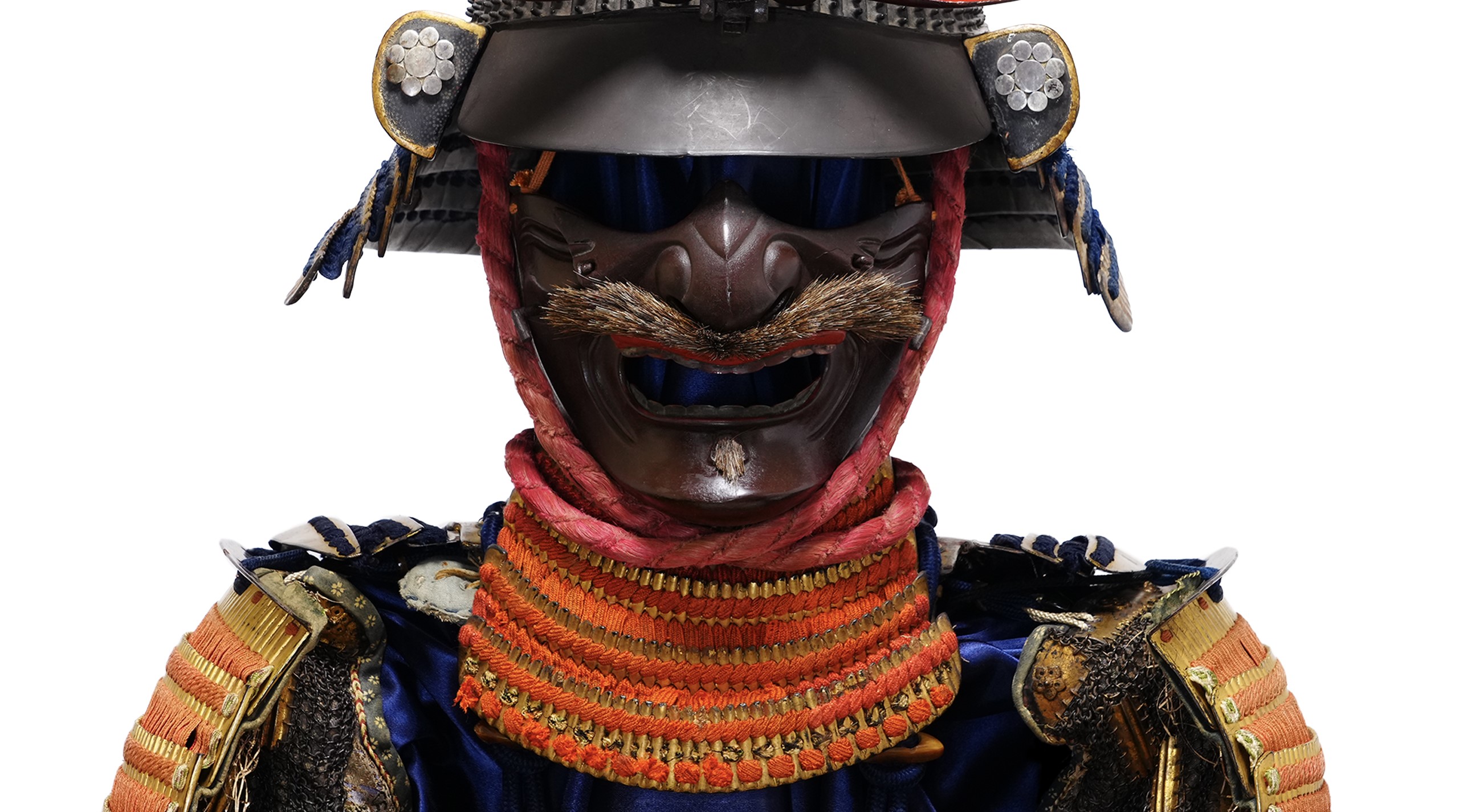
■ Maedate (front decoration): Nichirin/ Getsurin, Shikami
This Kabuto’s Maedatemonos (前立物) is a combination of two different decorations: a golden circle and a monster face. Firstly, please look at this golden ring part. We estimate the Nichirin (日輪, another name for the sun) or a Getsurin/Gatsurin (月輪, another name for the moon) is its model. There was a widespread belief among Samurai, the Myouken (妙見) belief. This religion was born in India. It was mixed with the Polestar belief and was brought to Japan from the continent. The sun, the moon, and the stars of the universe were the symbols of faith. The Myouken Bosatsu (妙見菩薩, 菩薩 means Bodhisattva) fulfills all wishes such as fertility of rich harvest, peace, the prosperity of the clan, healing of illness, longevity, success in business, traffic safety, academic achievement, marriage, etcetera. So, it is understandable that many Samurai cherished sun and moon motifs. The former owner of this armor might have shown his faith by wearing this Kabuto.
Now, let’s focus on another Maedatemono. You would see the figure of a monster-like face. We believe its motif is the Shikami/Shigami (獅噛). The name Shikami/Shigami comes from the word “顰 (pronounced as Shikami).” It refers to a terrifying Oni (鬼) mask with raised eyebrows, an open mouth with fangs bared, or a frowning Oni or lion mask. The Oni is a kind of monster and is often depicted as the following figure: a human body with horns and fangs. They are usually harmful to people but sometimes helpful. It is because Onis are not just monsters but are imagined in various forms, such as vengeful spirits of humans, legendary gods, Yōkai (妖怪, monster/ghost), and spiritual beings, and their definitions differ depending on the scene in which they appear. This Maedatemono’s Shikami has a grim, angry facial expression, and its long horns and large ears make it a virtuous enemy. Perhaps due to the combination of deep red lacquer and gold coloring, it gives off a strong impression of being gorgeous and intimidating. Even a young Samurai would have been intimidated by the enemy from a distance if he wore a Kabuto with this decoration.

Armor
■Dō (cuirass): Maru Dō
The Maru Dō (丸胴) is a kind of cuirass for the Tousei Gusoku (当世具足, developed armor style). It is a structure that was attempted when Hon Kozane Dō (本小札胴) using Hon Kozanes (本小札, a small board made of leather or iron about 5 to 7 cm long) or Iyonui Nobekawa Dutsumi (伊予縫延革包) using Iyozanes (伊予札, a type of armor Kozane devised by armorers in Iyo Province).
■Kusazuri (skirt of plates attached to the cuirass):
Lacquered iron Kusazuri laced with orange threads. While some cords for the Odoshi (縅, a technique for armor tying boards together with cords such as leather or thread) have torn due to aging, they are relatively in good condition, so each plate is tied without coming off.
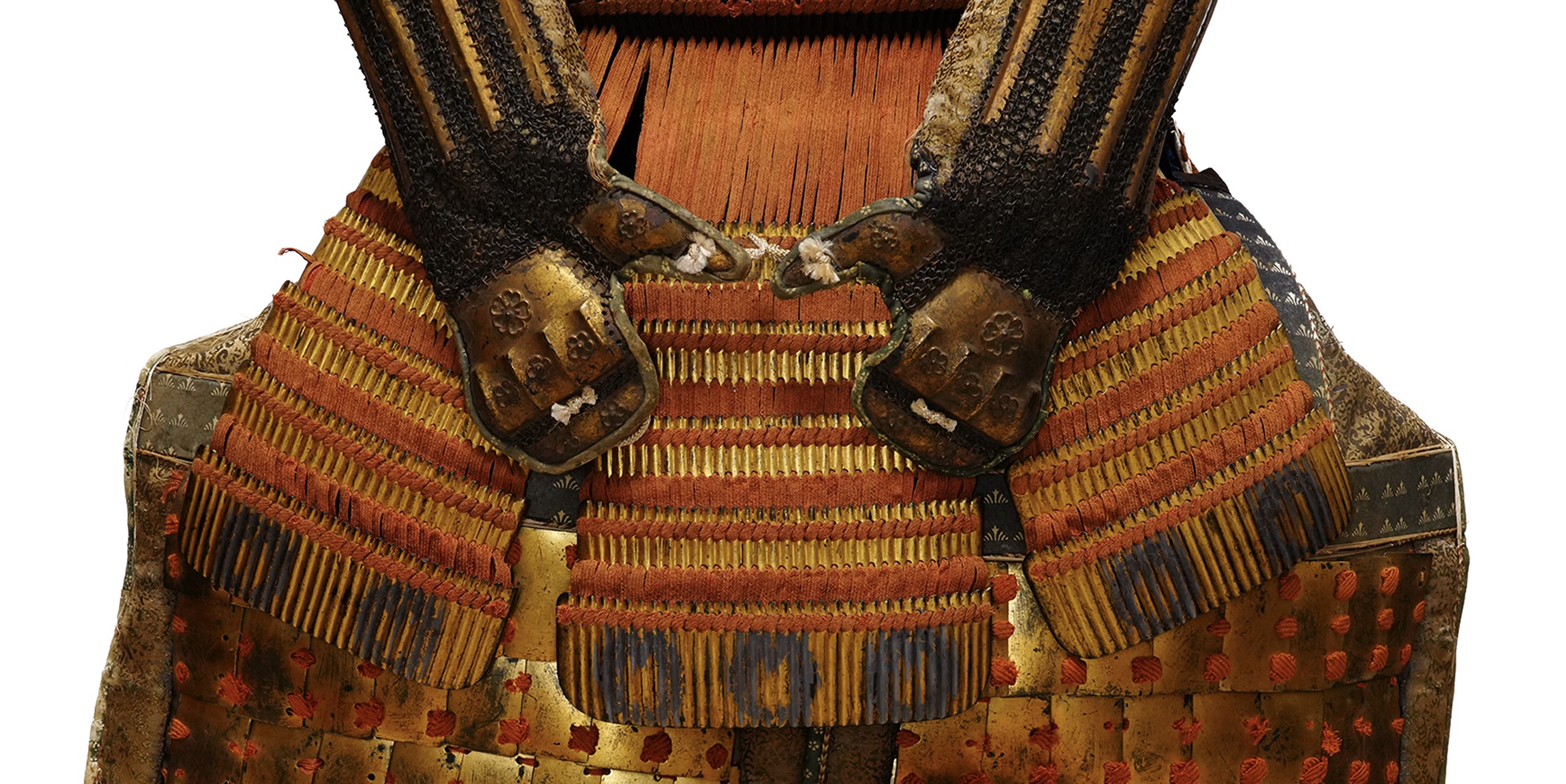
Small parts
■Kote (armored sleeves):
Intricate iron chain mail with silk.

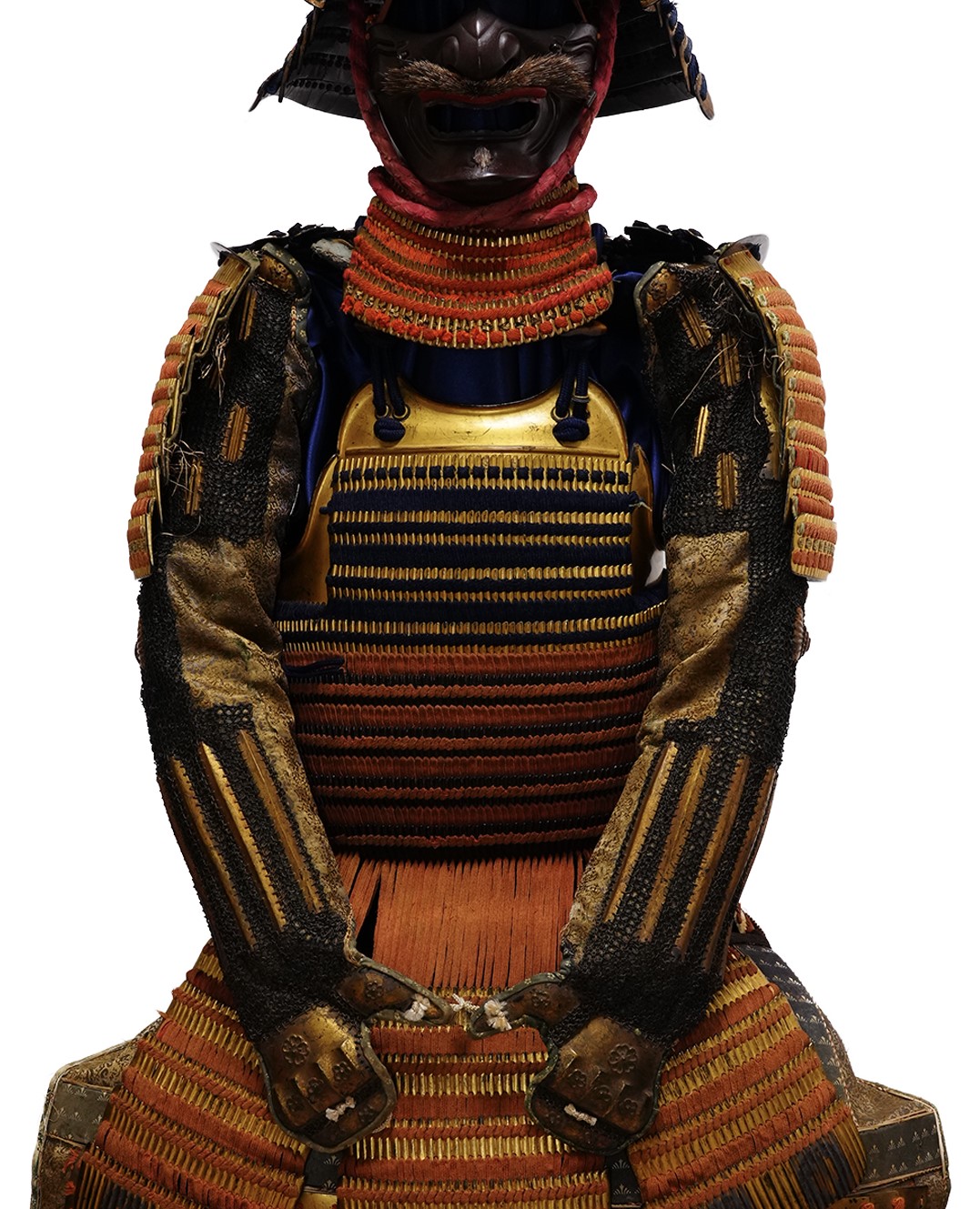
■Haidate (thigh protection):
The Haidate (佩楯) is a thigh guard. Gold-colored iron plates are attached to its cloth.
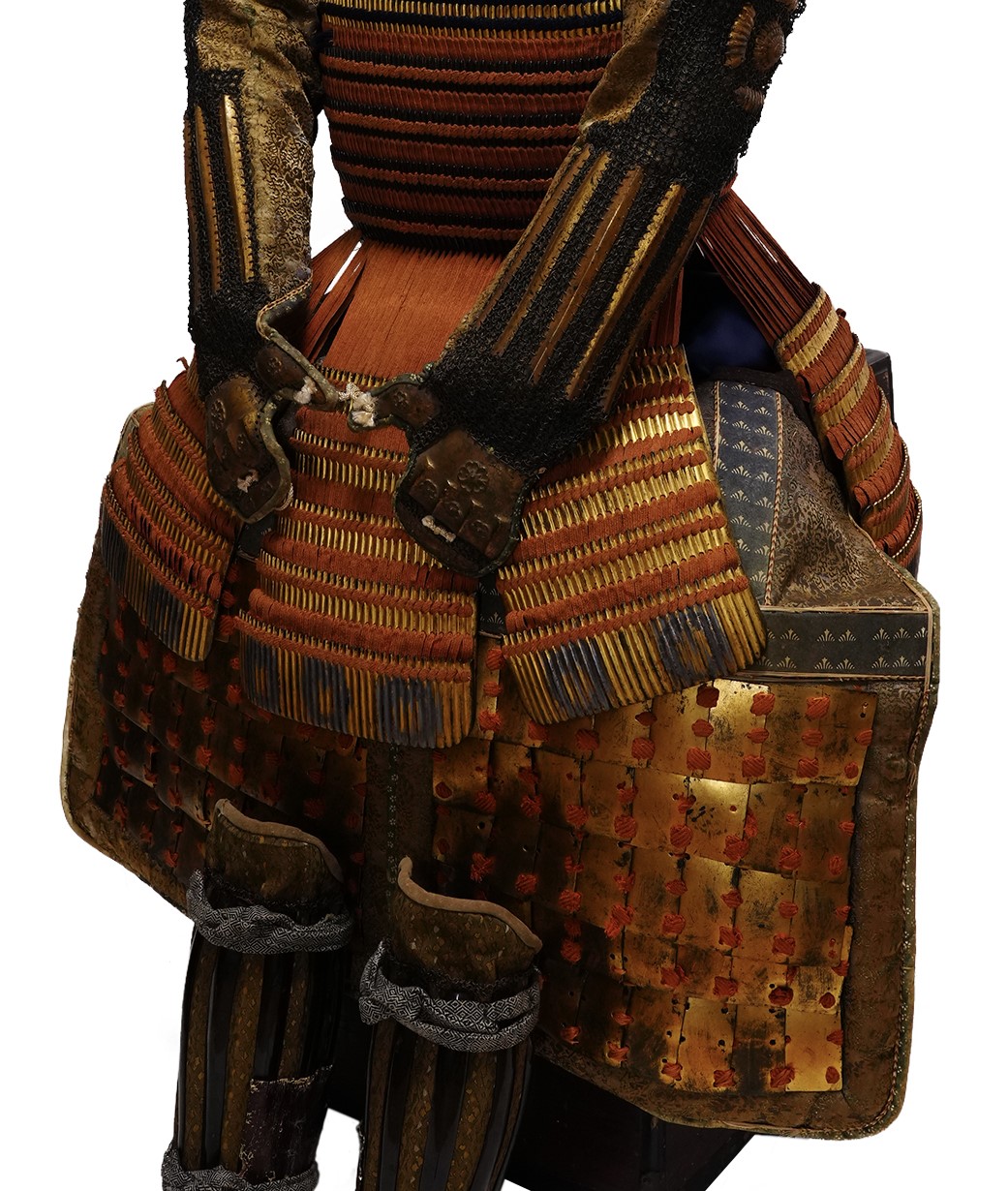
■Suneate (shin guard):
There are several types of Suneate (脛当), and we think this armor’s Suneate is categorized as the Shino Suneate (篠臑当). It is formed by arranging thin iron plates horizontally and pasting them onto cloth. The weak point was that areas where the fabric was exposed were less protective. However, its unique feature is that it has better adhesion than another type of Suneate called the Tsutsu Suneate (筒脛当), made of three iron plates joined together with a hinge.

■Gattari (Sashimono holder):
If you focus on the back of this armor, you will find that a ring-shaped metal frame is attached. It is a gear called the Gattari (合当理) that supports the upper part of the Sashimono (指物, a frag or decorative sign installed at the back of armor). And the Uketsutsu (受筒)/ Sashidutsu (指筒) is a tube to store a Sashimono. Samurai warriors judged their sides and enemies on the battlefields by checking the motifs designed for flags. Especially in group battles with infantry, this method was very effective because they could instantly identify affiliations.

Certification: Koushu Tokubetsu Kicho Shiryo Certificate
On November 6th 2022, this armor was appraised as a Koushu Tokubetsu Kicho Shiryo by The Association for the Research and Preservation of Japanese Helmets and Armor, which is the most trusted Japanese armor appraiser in Japan. Koushu Tokubestu Kicho Shiryo means special rare article. It is ranked as the second highest of five rankings.
The paper mentions the armor was made in the early Edo period (early-late 17th). You can receive this original authentication paper.
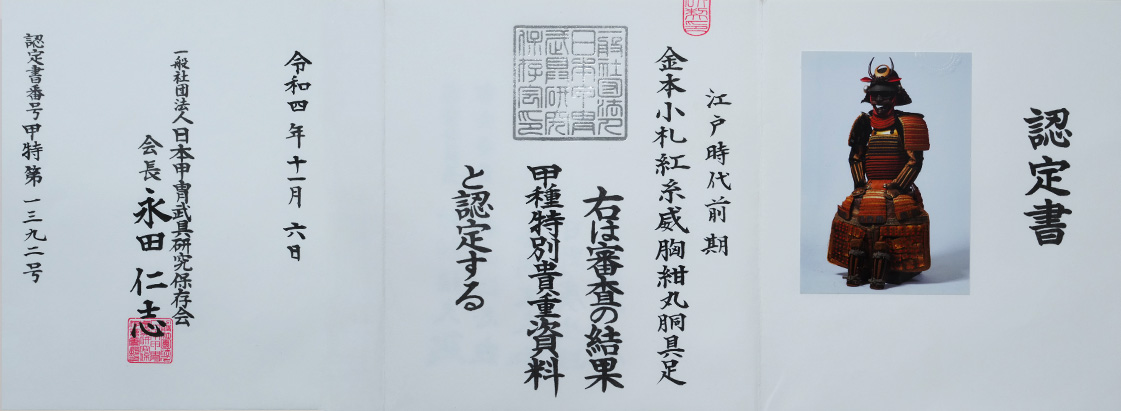
An English translation of the certificate is available on request. We won’t charge any additional fee.
【About us】
Samurai Museum is located in Tokyo, Japan, exhibiting antique artifacts related to the Samurai history. Samurai Museum Shop is the place for those who are interested in Japanese culture and craftsmanship. We deal with antique Samurai swords/armor, traditional crafts made in Japan and so on.
【Antique Japanese Armor and Export process】
After receiving the full payment from you, we will apply for its export permit from the agency for Cultural Affairs to legally export the antique Samurai armor to other countries. It normally takes around 2-4 weeks to receive this permit. And we would like you to expect at least 1-1.5 months for your order to arrive at your given address after you ordered.
【Payment method】
We accept payment through Stripe (Credit card), PayPal, Apple Pay or ChromePay, all of which are secure payment methods. Also, you don’t need to make an account on Stripe for the checkout. If you prefer other payment method, please contact us. You may either pay in JPY, USD, AUD, CAD, EUR, CHF or GBP. The price is set in Japanese Yen. Prices in other currencies are automatically calculated based on the latest exchange rate.

【Shipping duration】
We normally ship via EMS (Express Mail Service) provided by Japan Post. It usually takes at least 5-14 days to deliver the package after you place an order.
We offer Free International Shipping as long as we can ship your order by EMS. If you prefer other shipping carriers, please contact us.
We will inform you of the order’s tracking number via email. Please make sure you fill out your valid email address correctly.
*If you like to make sure if EMS shipping is available to your country, please contact us.

【How to make sure the condition】
Please keep in mind that what you are going to purchase is an antique item. We uploaded high resolution photos for you to check its condition thoroughly. If you like to see more photos with different angles, please feel free to contact us. We will be happy to send them to you so that you can make informed decision. It is essential for us to know that you are happy with your choice of a sword. and we are prepared to use the best of our ability to serve you.
【How To Contact Us】
Please contact us through email, Facebook Messenger or Live Chat if you have any questions. You can find each icon on the right side of the website. Please click one of them to reach us. We will reply to you within 1-2 business days.
【How To Preserve Antique Samurai Armor】
Dryness, humidity, and bad ventilation might deteriorate the condition of antique Samurai armor. The best temperature to preserve Samurai armor is around 20℃ in Celsius, and humidity should be about 60%. Direct sunlight should be avoided. We recommend storing armors in a room with good ventilation. If you like to display them outside the boxes for a prolonged time, we suggest using a glass case in order for dust not to be accumulated easily. In case you don’t use a glass case, please make sure to regularly dust off from the armor by using a soft brush made of delicate cloth or brush for painting.
If you like to know more about the preservation of this armor, please feel free to contact us.

